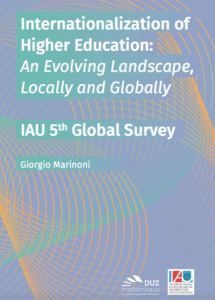Stay in the loop! Subscribe to our mailing list
The International Association of Universities (IAU) released earlier this month the much-awaited results of its most recent Global Survey, in the form of a publication titled “Internationalization of Higher Education: An Evolving Landscape, Locally and Globally”. The survey, in its 5th edition, is the most geographically encompassing collection and analysis of primary data on the internationalisation of higher education. The report looks into internationalisation trends over time and compares developments across regions, providing deeper insights into the evolution of the process. It highlights the overall increased importance of internationalisation, which is perceived to enhance international cooperation and capacity building, as well as to have a beneficial impact on the quality of teaching and learning. Nevertheless, the findings also reveal the limitations of the process and the main areas of concern, from funding scarcity, to the commodification of higher education, to language barriers, and the persistent challenges in the recognition of qualifications.
Concretely, relying on responses from 1 000 higher education institutions (HEIs) based in 126 different countries, the report covers the following areas:
Amongst multiple findings, the report shows that an overwhelming majority of institutions (more than 90%) have internationalisation mentioned in their mission/strategic plan. The only exception is North America, where almost one third of HEIs do not mention internationalisation in their strategic documents. The findings also show that the majority of HEIs attach a high degree of importance to internationalisation. However, this increase is observed mainly in HEIs where internationalisation was already held in high regard, whereas it has not taken place at HEIs where the level was low to begin with. In the longer run, this risks leading to growing inequality between HEIs. When it comes to the associated risks to internationalisation, the results show stability over time, with “international opportunities accessible only to students with financial resources” as the main institutional risk, followed by “difficulty to assess/ recognize quality of courses/programmes offered by foreign institutions” and “excessive competition with other higher education institutions”.
For a full overview of the main findings, see the Executive Summary of the report, which can be downloaded from the IAU website, whereas the full report can be ordered via the publisher.
